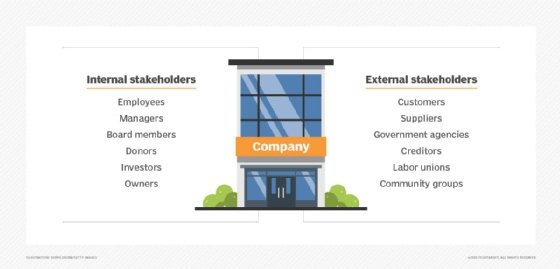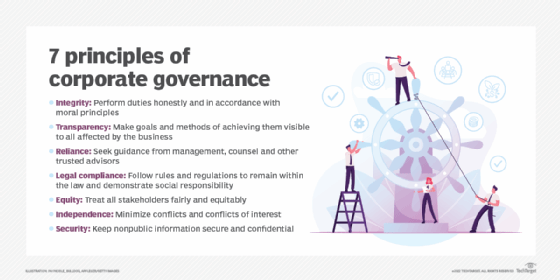stakeholder
What is a stakeholder?
A stakeholder is a person, group or organization with a vested interest, or stake, in the decision-making and activities of a business, organization or project. Stakeholders can be members of the organization they have a stake in, or they can have no official affiliation. Stakeholders can have a direct or indirect influence on the activities or projects of an organization. Their support is often required for business and project success.
The International Organization for Standardization's ISO 26000 is a set of international standards for corporate social responsibility. It offers the following criteria for identifying a stakeholder:
- An organization is legally obligated to stakeholders.
- They might be positively or negatively impacted by an organization's decisions.
- They are likely to express concerns and be involved in the activities of an organization.
Based on this criteria, stakeholders often include customers, employees, investors, suppliers, boards of directors, community members and organizations, and government entities. Stakeholder capitalism is a system in which an organization prioritizes stakeholders' interests.
The term stakeholder has its roots in horse racing. A stake race is one in which the prize money is derived from the entry fees that horse owners pay to enter the race. The entry fee is called a stake, a synonym for risk. The person or entity that takes care of the entry fees until the prize money is awarded is called the stakeholder. Traditionally, the stakeholder has no financial interest in the outcome of the race.

Types of stakeholders
Stakeholders can come from a variety of connections to the organization or project. The most common types of stakeholders include the following:
- Customers usually expect organizations to deliver products of value.
- Employees are often project stakeholders, who want to contribute to a project that is related to their job.
- Owners supply an organization's equity and capital and are responsible for organizational goals.
- Investors are shareholders, who invest in organizations in exchange for financial returns and often receive regular financial reporting on the companies they invest in as well as voting power in major decisions.
- Creditors, such as banks and bondholders, lend money to an organization to be paid back with interest.
- Suppliers are vendors that supply materials and products to organizations and have an interest in their business and the projects they pursue.
- Communities have an interest in businesses being healthy, safe and beneficial to local economies. Businesses create jobs and business for local communities. Environment, sustainability and governance (ESG) are increasingly important values for consumers and investors.
- Governments collect taxes from companies and their employees.

Internal vs. external stakeholders
Stakeholders are often categorized into the two main groups of internal stakeholders and external stakeholders.
Internal stakeholders
Internal stakeholders are those within a company whose interest stems from direct employment, ownership or investment. Internal stakeholders of a company or project can include employees, project managers, boards of directors, donors and investors. These individuals are often referred to as primary stakeholders, or key stakeholders, because they have a direct stake and important role in the company's or project's success.
External stakeholders
External stakeholders are those outside of a company who are indirectly affected by its decisions and outcomes. External stakeholders include customers, suppliers, government agencies, creditors, labor unions and community groups. These entities are also referred to as secondary stakeholders because their stake in the company or project is often more representational than direct.
Examples of stakeholders
Stakeholders exist across industries. For example, in healthcare, stakeholders are those who have a direct interest in healthcare services provided and the decisions made around them. These include doctors, nurses and other medical professionals; hospitals, clinics and healthcare providers; healthcare IT, medical equipment and other suppliers; governing bodies; nonprofit organizations; and patients.
Another example is a stakeholder in a legal process. There, a stakeholder is an individual or group in temporary possession of money or property while the owner is being determined in court.
In a project setting, the stakeholders are people who have direct influence on whether a project is successful. They include the following:
- customers, whose satisfaction with a product or project is the end goal of a project plan;
- project managers, who manage and lead a project;
- project sponsors, who finance a project; and
- project team members, who are the employees executing a project.
Stakeholders vs. shareholders: What is the difference?
Shareholders are stakeholders who are financially invested in an organization. While stakeholders are interested in a company's overall performance, shareholders have an added interest in the company's stock performance or return on investment.
A shareholder's investment helps fund an organization and its activities. Depending on the size of investment, shareholders can sometimes have more influence on an organization and its projects than stakeholders. Investment can grant shareholders the right to regular financial information about an organization and to participate in business decisions.
How to manage stakeholders
In the 1984 book, Strategic Management: A Stakeholder Approach, R. Edward Freeman emphasized the idea that a business is a system that's built on relationships, and no one part of the system can be viewed as an isolated entity. Freeman's stakeholder theory is an organizational and relationship-based management model. It is credited with helping to raise social consciousness in business about the value of treating stakeholders ethically.
In their 1983 article, "Stockholders and Stakeholders: A New Perspective on Corporate Governance," R. Edward Freeman and David L. Reed proposed that for a business to succeed, it must create value or be a value driver for the owners or stockholders. They also said that a business must create value for stakeholders who do not have a direct financial interest in the company's success, but without their help, the business could not exist. According to Freeman and Reed's analysis, the job of the entrepreneur is to find out who the stakeholders are and determine where their interests intersect with those of the stockholders.
Today, the key components in managing stakeholders include analysis, prioritization and engagement.
Stakeholder analysis
This analysis start with the process of identifying and ranking a project's major stakeholders. Once stakeholders are identified, stakeholder analysis weighs the demands and influence of those stakeholders, then ranks which ones are most likely to influence or be influenced by the company's actions. This information is used to make more balanced and effective business decisions.
Stakeholder analysis is a central part of stakeholder management, which is a process that studies the varying motives and concerns of stakeholders to cultivate positive relationships. Both internal and external stakeholders must be considered when conducting stakeholder analysis.

Prioritize the major stakeholders
Projects often have several major stakeholders with different interests and values. Once an organization or project has identified and ranked those stakeholders, it often identifies at what stage those different stakeholders should be prioritized and engaged with. For instance, investors are prioritized at the beginning of a project to elicit their investment. They might also get status reports at set intervals. By contrast, project management best practices recommend that project team members be engaged more regularly as a project progresses.
Stakeholder engagement
A successful stakeholder management strategy depends on strong, productive stakeholder engagement. This involves proactive engagement with stakeholders throughout the various phases of a project. A key part of this engagement is learning and meeting stakeholders' expectations and goals. Organizations should document stakeholder interests, consistently follow up with them through a communication plan and provide them with status reports.
The interests and values of stakeholders have a vital influence on modern businesses. Learn how the benefits of ESG values are influencing consumers, investors and businesses.







